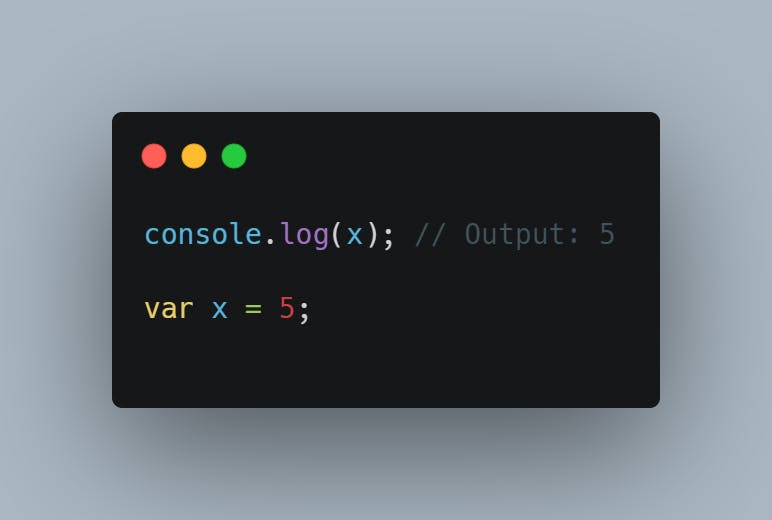Hoisting moves JavaScript declarations to the top. pe. This can be confusing for beginners since it can seem like the code is being executed in a different order than it is written. However, understanding hoisting can help write more efficient and error-free code.
-What is hoisting?
In JavaScript, hoisting is the process of moving declarations to the top of their scope. Hoisting happens automatically for both variables and functions. This means that even if you declare a variable or function after you use it, the declaration is still processed before any code is executed.

The output of this code is undefined because the variable x is hoisted to the top of its scope and initialized with a value of undefined. Even though the console.log statement comes before the variable declaration, the declaration is processed first and x is given a value of undefined. Only then is the code executed, which outputs undefined to the console.
If we change our code slightly and initialize x with a value, we can see how this affects hoisting:

In this case, since x is initialized with a value of 5, that value is hoisted to the top of its scope and used when the console.log statement is executed. The result is that 5 is output to the console.
-How does hoisting work in JavaScript?
In JavaScript, hoisting is the process of moving declarations to the top of their scope. This applies to both variables and functions. Hoisting is important because it affects the order in which code is executed.
For example, consider the following code:

The variable x is declared after the console.log() statement, but because of hoisting, the declaration is processed first. This means that when the console.log() statement is executed, x has not yet been declared, and so it prints undefined.
-What are the benefits of hoisting?
One benefit of hoisting is that it makes it easier to read code. This is because declarations are moved to the top of the scope, so they can be declared all in one place. This can make code less cluttered and easier to understand.
Another benefit of hoisting is that it can help prevent errors. For example, if a variable is declared after it is used, an error will occur. However, if the variable is declared before it is used, no error will occur. This is because the declaration is processed first, so the variable will always be available.
Hoisting can also make code more efficient. This is because declarations are processed before any code is executed. This means that they can be processed as soon as the code is loaded, without having to wait for execution. This can make code run faster and use fewer resources.
-What are the drawbacks of hoisting?
One potential drawback of hoisting is that it can make code difficult to understand. This is because variables and functions can be declared in different places, and the order in which they are executed can be confusing.
Another potential drawback is that hoisting can make code less efficient. This is because declarations are processed before any code is executed, which means that unnecessary processing can occur.
Finally, hoisting can also cause errors if not used correctly. For example, if a variable is declared without a value, it will be given the value undefined. This can lead to unexpected results if the variable is used before it is given a proper value.
-How can you avoid issues with hoisting
One way to avoid issues with hoisting is to declare all variables at the top of their scope. This means that they will be processed before any other code in that scope, so there will be no chance of them being undefined.
Another way to avoid issues with hoisting is to use the 'strict mode' pragma. This pragma tells the JavaScript engine to process code more strictly, and one of the things it does is disallow undeclared variables. So, if you use strict mode, you will get an error if you try to use a variable that has not been declared.
Finally, you can choose to use a tool like JSLint, which will statically analyze your code and warn you about any potential hoisting issues.
conclusion
Hoisting is a process in JavaScript that moves declarations to the top of their scope. Hoisting is important because it affects the order in which code is executed. Hoisting can make code difficult to understand and less efficient and can cause errors if not used correctly. To avoid issues with hoisting, you can declare all variables at the top of their scope, use strict mode, or use a tool like JSLint.
